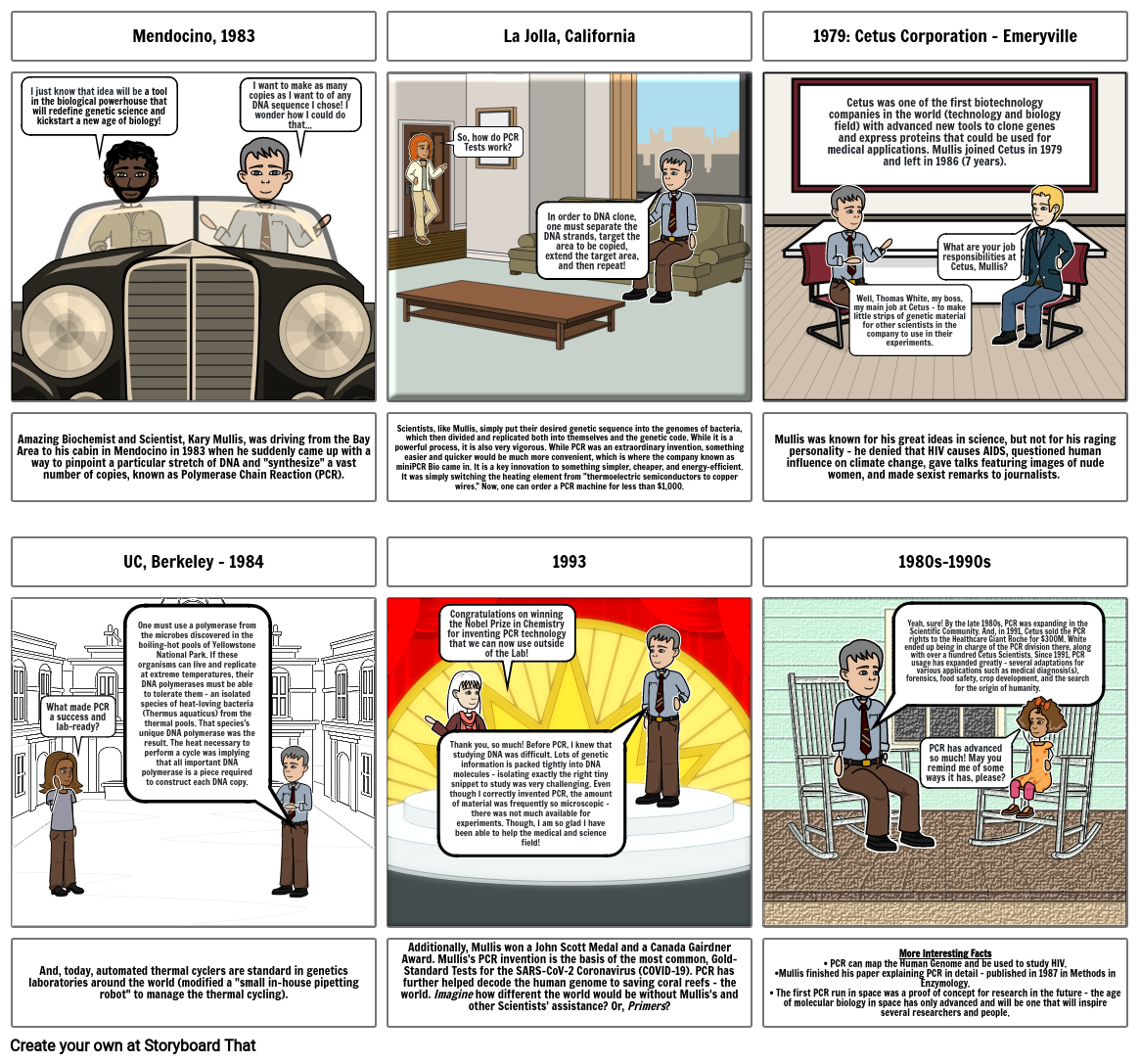Storyboard: Kary Mullis - Developer of PCR

Texto del Guión Gráfico
- Mendocino, 1983
- I just know that idea will be a tool in the biological powerhouse that will redefine genetic science and kickstart a new age of biology!
- I want to make as many copies as I want to of any DNA sequence I chose! I wonder how I could do that...
- La Jolla, California
- So, how do PCR Tests work?
- In order to DNA clone, one must separate the DNA strands, target the area to be copied, extend the target area, and then repeat!
- 1979: Cetus Corporation - Emeryville
- Cetus was one of the first biotechnology companies in the world (technology and biology field) with advanced new tools to clone genes and express proteins that could be used for medical applications. Mullis joined Cetus in 1979 and left in 1986 (7 years).
- Well, Thomas White, my boss, my main job at Cetus - to make little strips of genetic material for other scientists in the company to use in their experiments.
- What are your job responsibilities at Cetus, Mullis?
- Amazing Biochemist and Scientist, Kary Mullis, was driving from the Bay Area to his cabin in Mendocino in 1983 when he suddenly came up with a way to pinpoint a particular stretch of DNA and "synthesize" a vast number of copies, known as Polymerase Chain Reaction (PCR).
- UC, Berkeley - 1984
- One must use a polymerase from the microbes discovered in the boiling-hot pools of Yellowstone National Park. If these organisms can live and replicate at extreme temperatures, their DNA polymerases must be able to tolerate them - an isolated species of heat-loving bacteria (Thermus aquaticus) from the thermal pools. That species’s unique DNA polymerase was the result. The heat necessary to perform a cycle was implying that all important DNA polymerase is a piece required to construct each DNA copy.
- Scientists, like Mullis, simply put their desired genetic sequence into the genomes of bacteria, which then divided and replicated both into themselves and the genetic code. While it is a powerful process, it is also very vigorous. While PCR was an extraordinary invention, something easier and quicker would be much more convenient, which is where the company known as miniPCR Bio came in. It is a key innovation to something simpler, cheaper, and energy-efficient. It was simply switching the heating element from "thermoelectric semiconductors to copper wires." Now, one can order a PCR machine for less than $1,000.
- 1993
- Congratulations on winning the Nobel Prize in Chemistry for inventing PCR technology that we can now use outside of the Lab!
- Mullis was known for his great ideas in science, but not for his raging personality - he denied that HIV causes AIDS, questioned human influence on climate change, gave talks featuring images of nude women, and made sexist remarks to journalists.
- 1980s-1990s
- Yeah, sure! By the late 1980s, PCR was expanding in the Scientific Community. And, in 1991, Cetus sold the PCR rights to the Healthcare Giant Roche for $300M. White ended up being in charge of the PCR division there, along with over a hundred Cetus Scientists. Since 1991, PCR usage has expanded greatly - several adaptations for various applications such as medical diagnosis(s), forensics, food safety, crop development, and the search for the origin of humanity.
- And, today, automated thermal cyclers are standard in genetics laboratories around the world (modified a "small in-house pipetting robot" to manage the thermal cycling).
- What made PCR a success and lab-ready?
- Additionally, Mullis won a John Scott Medal and a Canada Gairdner Award. Mullis's PCR invention is the basis of the most common, Gold-Standard Tests for the SARS-CoV-2 Coronavirus (COVID-19). PCR has further helped decode the human genome to saving coral reefs - the world. Imagine how different the world would be without Mullis's and other Scientists' assistance? Or, Primers?
- Thank you, so much! Before PCR, I knew that studying DNA was difficult. Lots of genetic information is packed tightly into DNA molecules - isolating exactly the right tiny snippet to study was very challenging. Even though I correctly invented PCR, the amount of material was frequently so microscopic - there was not much available for experiments. Though, I am so glad I have been able to help the medical and science field!
- More Interesting Facts• PCR can map the Human Genome and be used to study HIV.•Mullis finished his paper explaining PCR in detail - published in 1987 in Methods in Enzymology.• The first PCR run in space was a proof of concept for research in the future - the age of molecular biology in space has only advanced and will be one that will inspire several researchers and people.
- PCR has advanced so much! May you remind me of some ways it has, please?
Más de 30 millones de guiones gráficos creados

